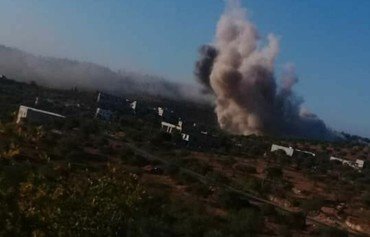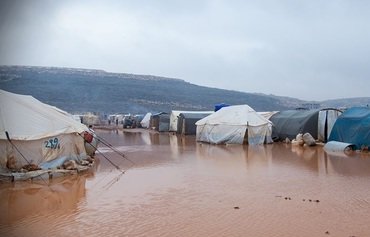Fighting in north-west Syria has rendered large parts of the region uninhabitable for civilians now crammed into an ever-shrinking area where conditions are dire, according to a report released Wednesday (March 4th).
The Harvard Humanitarian Initiative's Signal Programme analysed satellite imagery of towns and camps in Idlib province, where the Syrian regime has been pressing a devastating offensive since December.
"In the areas examined, the researchers estimate that nearly one-third of buildings have been significantly damaged or destroyed," said a statement released with the report, which Harvard produced with Save the Children and World Vision.
"With most of these areas' inhabitants having fled before or during the offensive, the destruction of homes and vital civilian infrastructure will make it nearly impossible for families to return in the near future," the statement added.
![An aerial photograph shows tents sheltering Syrians who fled ongoing battles in Idlib province, surrounded by mud caused by heavy rain, in a displacement camp near Sarmada close to the border with Turkey on December 29th. [Aref Tammawi/AFP]](/cnmi_di/images/2020/03/04/22823-Idlib-tent-city-600_384.jpg)
An aerial photograph shows tents sheltering Syrians who fled ongoing battles in Idlib province, surrounded by mud caused by heavy rain, in a displacement camp near Sarmada close to the border with Turkey on December 29th. [Aref Tammawi/AFP]
The satellite imagery analysed in the report shows agricultural fields filling up with camps for the displaced in a matter of months, as well as levelled villages and towns.
Regime and allied forces backed by Russian airstrikes have clawed back significant territory since December, triggering a massive exodus of a scope yet unseen in the nine-year-old Syrian conflict.
Routing bombing of schools and hospitals has forced civilians to flee town after town, heading towards the Turkish border. Some three million people are now trapped in the ever-shrinking enclave in dire conditions.
'Targeted civilian infrastructure'
"In the best case scenario, which is an immediate ceasefire, it will take months if not years to first physically rebuild the destroyed civilian infrastructure and then rebuild the trust for these communities to go back home," Save the Children spokeswoman Joelle Bassoul said.
A report released Monday by the UN Human Rights Council's Commission of Inquiry on Syria suggested the regime had intentionally targeted civilian infrastructure to scare the population away and facilitate its military reconquest.
"Attacks carried out by [pro-regime] forces targeted civilian infrastructure, including specially protected objects," the UN commission said.
"As a result, civilian areas were rendered uninhabitable," it added, citing the key Idlib province towns of Maaret al-Numan and Khan Sheikhun.
It said the levelling of certain towns was carried out "in an apparent effort to accelerate capture of strategic motorways".
More than half of the nearly one million people displaced over the past three months are children, tens of thousands of whom are sleeping rough in the bitter cold.

![An aerial view taken February 6th shows smoke billowing from tires burnt by Syrians in an attempt to hinder airstrikes amid clashes between regime and opposition fighters in the Idlib province town of Binnish. [Omar Haj Kadour/AFP]](/cnmi_di/images/2020/03/04/22821-Binnish-ariel-view-600_384.jpg)





